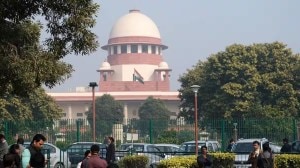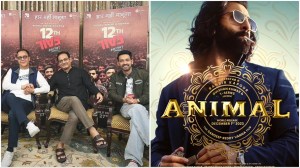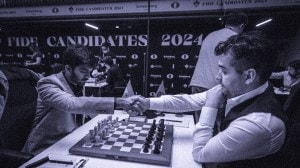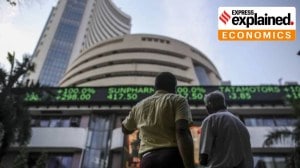- India
- International
A day in the life of National War Memorial: ‘Sometimes, it is important to kill’
Amid India-Pak tension, at the new memorial for killed soldiers, peace gets a faint hearing.
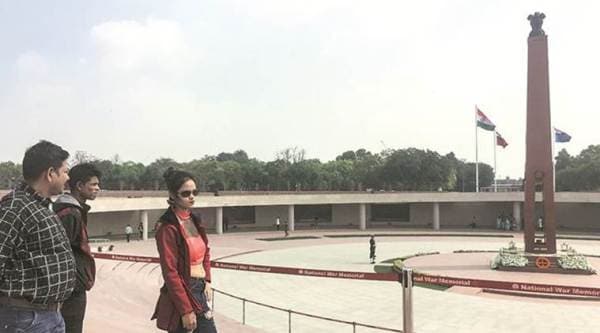 Deboshree with husband Rafiq (centre) from Assam at the Memorial. (Express photo by Abhinav Saha)
Deboshree with husband Rafiq (centre) from Assam at the Memorial. (Express photo by Abhinav Saha)
Abhiram and Halim Mansuri became friends a week ago.
A 16-year-old Class 11 student from Laxman Pur village in Rae Bareli district, Abhiram arrived in the Capital a fortnight ago to meet his relatives, who live in a slum near Paharganj. Around the same time, Mansuri, 30, a farmer from Tikamgarh in Madhya Pradesh, decided to take a break to visit his extended family, who reside in the same slum.
With their family members busy with their daily jobs, the two men have been exploring the city together. On a Tuesday morning — the last day of their vacation — the friends are at the newly built National War Memorial. “I had seen it on TV,” says Abhiram, pulling out a picture of the Memorial on his smartphone. Mansuri has even made some effort for the trip — he is dressed in military fatigues trousers and boots. “I bought them from a shop in Paharganj,” he smiles.
Around 10 am, with the crisp March sun beating down on the 40-acre property abutting India Gate, the men begin their rounds of the Memorial’s four ‘chakras’ — the ‘Amar Chakra’ or Circle of Immortality, the ‘Veerta Chakra’ or Circle of Bravery, the ‘Tyag Chakra’ or Circle of Sacrifice, and the ‘Rakshak Chakra’ or Circle of Protection.
Inaugurated by Prime Minister Narendra Modi on February 25, the Memorial has names of 25,942 martyrs killed in wars in 1947-48, 1962, 1965, 1971 and 1999 inscribed on 16 ‘honour walls’ in two concentric circles — with the names, ranks and regiments of the soldiers written on individual granite blocks.

Abhiram and Mansuri decide to start from the centre of the Memorial, which has a stone obelisk with ‘Amar Jawan’ inscribed on it, and the ‘Eternal Flame’. Around the obelisk are bronze murals depicting the wars.
“The battle of Longewala was one of the major decisive battles fought on the Western sector during the India-Pakistan war of 1971,” Abhiram reads out the text on one of the murals, taking long pauses. “I can read English,” he declares, going on to translate the sentence for his new friend. Mansuri nods, and the two men get into a discussion about the recent India-Pakistan face-off following the terror attack in Pulwama that killed 40 CRPF men.
“Modiji ne sahi jawab diya (PM Modi gave the right response). Everyone in my village supports him. We have been watching the videos on WhatsApp,” says Mansuri. “In Rae Bareli too, people are changing their mind. Rahul Gandhi could not have done this,” Abhiram agrees, going on to take a selfie at the mural. Mansuri is not too comfortable and turns his back.
A few metres away, at the ‘Battle of Tithwal’ mural, a group from Mumbai, who is here on a school trip, are discussing the death toll following India’s strike on Pakistan terror camps.
“352 terrorists were killed,” announces Piyush Shah, 14, a Class 10 student from Mumbai’s St Gregorios High School. “The Pulwama attack was carried out by the same terrorist who was released by India (referring to Masood Azhar). I have seen it in the news,” he says, as some Class 6 students listen keenly.
Jash, 11, and Aarush, 10, admit they are not allowed to see prime time news debates on television, but ask their senior if he is sure about the death toll. “Yes,” replies Piyush. “It was a late-night attack.”
Piyush’s classmate, Krishnan, 15, is not too convinced. “War is not the answer. It leads to death,” he says. But soon stops, as some of his classmates mock him for speaking in an accent. Piyush takes up again, now doling out information about Wing Commander Abhinandan Varthaman. “India put a lot of pressure on Pakistan for his release,” he says.
However, not all visitors have India and Pakistan on their minds. A group of civil service aspirants are going around taking notes from the boards put up around the structure. Newly-weds Amar (30), a travel guide, and Neema (28), from Mandi in Himachal Pradesh, say they just wanted an open space to walk around and chanced upon the Memorial while visiting India Gate. Deepak Patel (50) and his colleagues from the Ahmedabad Income Tax Department, on their way to Chandigarh for a football tournament, have decided to make a day’s halt in the Capital. It’s their first trip to Delhi and they have their phones fixed on selfie sticks to take pictures.
In one corner, a group of men and women from Mysore district’s Urban Development Cell — who are in the Capital to receive a Swachh Bharat award — are crowded around Sepoy G Santosh, 32, who is explaining the Memorial’s structure to them in Kannada.
“Eighteen of us came here three months ago and were trained. Since there are no guides here, many tourists ask us about the Memorial,” says Santosh, who joined the Army in 2009. “Every day, I come at 7 am and leave at 1 pm. Then, I come at 8 pm and stay till midnight. We have also been trained to tackle medical emergencies. In all, there are 104 soldiers deployed at the Memorial from the Madras, Assam and Sikh regiments,” he says.
Twenty-year-old ‘model’ Deboshree Deb — dressed in a snug crop top, ripped jeans and chunky shades — arrives with husband Rafiq Khan, 28, a driver. From Silchar in Assam, they are on a holiday to Delhi. The couple know little about the Memorial, and their driver, Iftiqar Ansari, 40, takes the lead. Pointing to the plaques he says, “Ye jung ki yaadein hain (These are memories of war). This has been built by Modiji.” The couple simply nod. After a few minutes, they lose interest. The two men then spend their time taking pictures of Deboshree on their phones, as she poses at different spots.
Hans, a 65-year-old tourist from Denmark, is more involved. “How many soldiers were killed in the war with China?” he asks a few people, who stare at him blankly. Some of them ask him to pose for selfies. He declines. “I have seen war memorials in Thailand and South Korea. This is as good as them. War is never good, but India is the oppressed one. I feel sad reading about these soldiers,” he says, as one of the guards instructs him to read the murals to find out about the war with China. A little distance away, a group of hotel management students are going through the names of the soldiers, and debating the pros and cons of war. It’s a divided house.
“Maarna bhi toh zaroori hai (Sometimes, it is important to kill),” says Kavalpreet Singh, 23, a student of Institute of Hotel Management, New Delhi. His friend Rahul Kohli, 21, promptly rebuts him: “Look around, so many of our men have also been killed. Every war sets you back by 10-15 years. Aren’t there bigger issues such as education and health that this government needs to tackle?”
After a fervent discussion, the group settles on this: “We have given Pakistan many chances, Modiji had to do something. But in the future we should ignore them,” says Singh.
Around 1 pm, Mansuri and Abhiram prepare to leave. “We have exchanged phone numbers. I have told him to join Facebook, we can stay in touch,” says Abhiram. They have also decided on something else. “Our families will vote for Modiji now,” says Mansuri.
Apr 16: Latest News
- 01
- 02
- 03
- 04
- 05
















